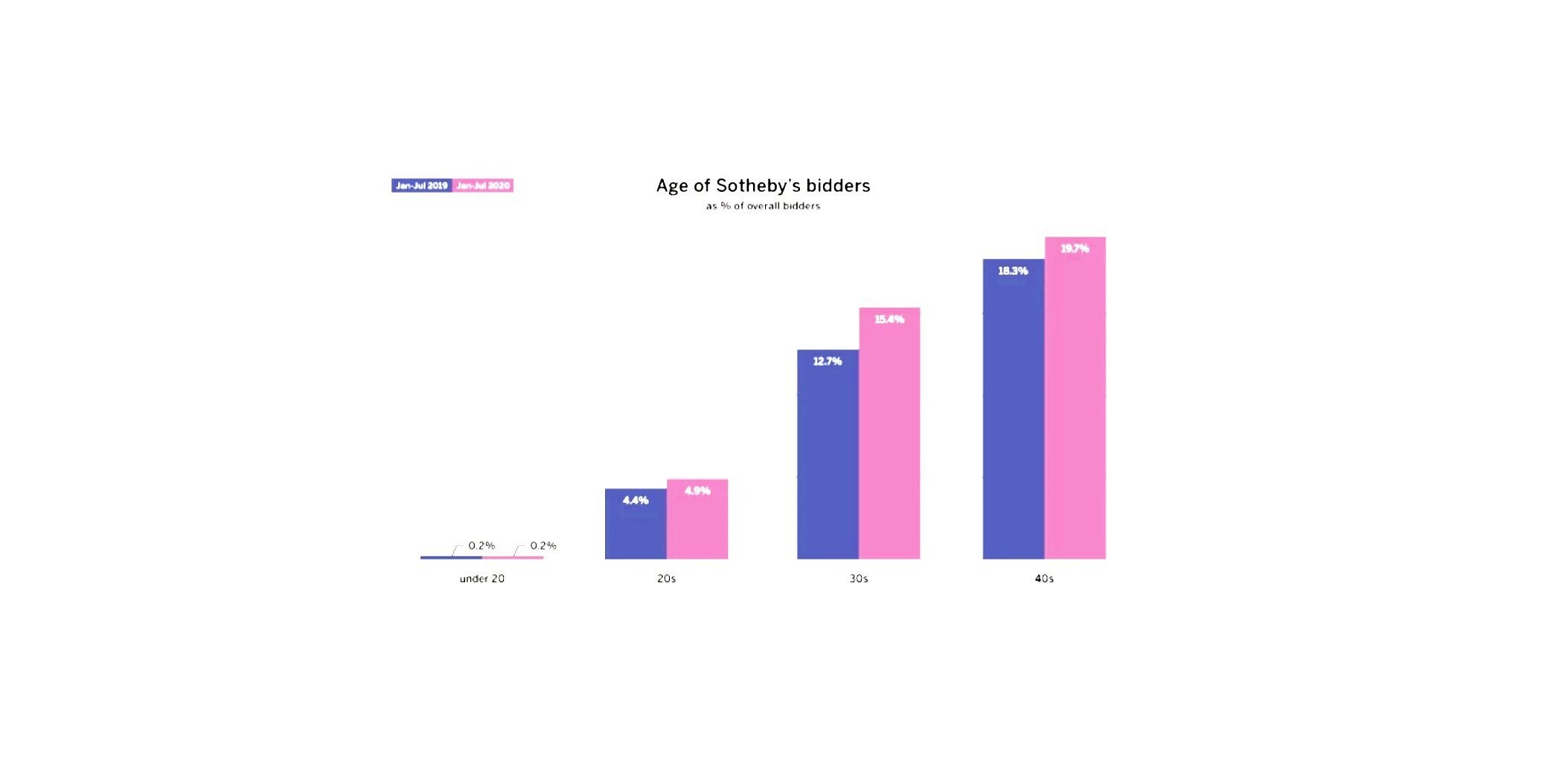Attracting Tomorrow's Bidders: Unveiling Strategies for Fresh Audiences in Auction Houses
In the age-old theatres of bidding and acquisitions, auction houses have scripted tales of elegance, rarity, and cultural legacy. However, with the new era approaching and with existing bidders ageing, a question arises of how auction houses will transcend the echoes of the past to resonate with a dynamic, diverse, and digitally driven audience.
Shedding light on how auction houses have changed since the digitalisation of the world and, more importantly, how they are striving to captivate the attention of a new generation of potential buyers.This article will explore three fundamental pillars through which auction houses have actively reshaped both their demographic appeal and overall image: a commitment to education, the integration of digitalisation, and the cultivation of strategic partnerships. [1]
Sotheby’s 20th Century & Contemporary Art Evening Sale. New York, June 30, 2020. Photo Courtesy: Sotheby’s.
Education
The first pillar I want to start with is education. There is a unanimous understanding among auction houses that without actively educating future audiences in the art world, the prospect of attracting new bidders remains a challenge. This makes education the primary cornerstone that transforms the art appreciation landscape and the pivotal catalyst for cultivating a broader, more discerning audience eager to participate in the auction experience.
Each major auction house has a programme designed to educate future audiences. Christie’s hosts Christie’s Lates, an evening event each month that provides free food and drinks and offers guest lectures. Phillips launched its Art Matters panel discussion series, hosted by Arnold Lehman, former director of the Brooklyn Museum and Sotheby's hosts intimate evenings, teaching attendees how to check Old Masters artworks' condition, attribution, provenance, and quality. [2]
It is a mutual understanding in the sphere of auction houses that it is significantly harder to sell art if one does not know about it. Furthermore, the appeal of collecting art is to engage in a vibrant community and cultivate a language for contemplation and discourse on visual art. Thus, it is important to educate people about the world of art.
However, despite that, it is interesting to point out that each auction house appears to teach something different. Christie's and Philipps focus on Contemporary Art, whilst Sotheby's suggests it is vital to educate younger audiences about old masters'. Despite the differences in subject matter, it becomes clear that any education within the art sphere and any engagement of younger audiences within the art world is at the forefront of these events, suggesting that the genre is less important than how the event is structured. This brings us to conclude that the channel of delivery is much more critical when engaging younger and new audiences within the auction house sphere than the actual artworks sold. This trend becomes further visible when observing the other two pillars discussed in this article.
Art Matters panel discussion at Phillips in 2019. Photo Courtesy: Phillips.
Auction Houses' Tech Transformation
It is no secret that our world is changing drastically, and that digital innovation is its driving force. Thus, it should come as no surprise that auction houses had to act on this change in order to stay relevant. One auction house in particular, Sotheby's auction house, stands out in this. Sotheby’s has wholeheartedly embraced technology, utilising its transformative power to broaden its outreach significantly. [3]
Sotheby’s has a TV app, the Metaverse, and is constantly pushing the boundaries of VR (Virtual Reality) and AR (augmented reality). These multiple streams of tech transformation pose the question of whether this approach had any success.
Without any doubt, the introduction of these different approaches impacted its audience. A TV app allows Sotheby's to seamlessly integrate its auctions into the digital living rooms of art enthusiasts worldwide. While pushing the boundaries of VR and AR, explores different ways of viewing art and attracts younger audiences through a different approach.
However, to determine which audiences these changes attracted, one has to analyse metrics such as user engagement, customer feedback, and the overall impact on the auction house's market share. [4] Looking at recent reports shared by Sotheby's, one can see that audience engagement, particularly of younger audiences in Sotheby's, has grown since 2019. Sotheby's registered a 22.5% increase in bidders in their 20s and 30s from the previous year in 2019. This data suggests that the adoption of digital innovation may play a role in gaining interests of younger audiences. [5]
Figure 1, Age of Sotheby's Bidders. Photo Courtesy: Sotheby’s.
However, exploring the growth of online bidding in auction houses is also interesting. If one looks at the data presented below in Figure 2, one can see an increase in online bids within the auction house sphere, further speaking that auction houses will have to engage with digital innovation to stay relevant and engage new audiences. While Sotheby's is already doing that and pushing the boundaries of digital innovation within the art world, it will be interesting to explore how Philipps, Bonham's, Christie's, and other major auction houses will respond to this data. [6]
Figure 2, Lots Sold at Sotheby's, Christie's and Philips. Photo Courtesy: Sotheby’s.
However, what remains clear and becomes further visible when analysing this data and digital innovative approaches is that the change of method attracted new audiences. The emphasis on exploring thematic elements, such as the genre of an artwork, takes a backseat in comparison to the transformative power wielded by a change in the method of delivery itself.
Cultivation of Strategic Partnerships
Similar to digitalisation, the cultivation of strategic partnerships builds a key pillar in attracting new audiences. When one looks at the cultivation of partnerships, it becomes evident that the partnerships have been strategically based to attract younger audiences. Collaboration with so-called influencers has become especially interesting in the auction house sphere.
An influencer is a person with the ability to influence potential buyers of a product or service by promoting or recommending the items on social media. One example of this would be the collaboration of Sotheby's in Asia with Asian pop Icon T.O.P. By showcasing a pop icon of the younger generation and introducing artworks over their social media as well as the #TTTOP auction ignited unprecedented levels of interaction, surpassing 26,000 views on Sotheby's Instagram and accumulating over 830,000 likes on Weibo.
However also, partnering up with artists and creating products like clothes, skateboards, and sneakers has become highly interesting for auction houses. So, there has been a partnership with Christie's and clothing brands such as Supreme. Where, for instance, a set of three Damien Hirst–designed skateboard decks were on offer. [7]
A result of a Sotheby's and Highsnobiety collaboration. Photo Courtesy: Sotheby’s.
Once again, it becomes visible that the theme of the art is not so important when attracting new audiences; instead, the channel and method of delivery plays a crucial role. In this context, the significance of utilising influencers is underscored, as the specific art endorsed by these influencers plays a pivotal role in shaping the sales outcomes within auction houses. Notably, the focus in these instances has been on contemporary artworks.
Conclusion
In conclusion, auction houses are adapting to the ever-changing world and are trying to engage younger audiences. However, it is apparent that the theme does not lie at the forefront of their marketing strategies but rather the method and channel of delivery. Here, an increase in digital media becomes visible. This innovative strategy in captivating younger audiences can be attributed to auction houses' efforts to shed their exclusive and secluded image, aiming to familiarise new audiences with the dynamics of future bidding. Looking ahead, it is conceivable that auction houses will increasingly shift towards thematic marketing approaches, moving away from focusing solely on the medium. Yet, currently, such a transition appears challenging due to the current generation's uncertainty about their preferences in the art world.
Footnotes:
Cohen, “To Attract Young Collectors.” Artsy, January 29, 2020.
Ibid.
Olson, “How Auction Houses Are Engaging Younger Collectors.” ADPRO, February 23, 2018.
Klein, “New Buyers Prove Art Market Resiliency and More Key Insights.” Sotheby's, September 25, 2020.
Ibid.
Ibid.
Cohen, “To Attract Young Collectors.” Artsy, January 29, 2020.
Sandra Nikusev
Art Markets Co-Editor, MADE IN BED






